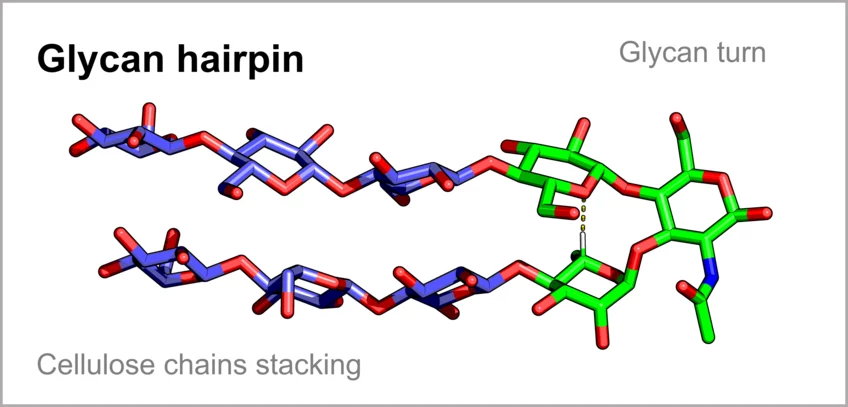The Max Planck Institute of Colloids and Interfaces (MPICI) has created a carbohydrate sequence that can fold into a stable secondary structure. To date, self-folding biopolymers had only been produced for DNA and proteins, and sugars were thought to be too flexible to adopt a stable shape. Folded carbohydrates have the potential to open up entirely new avenues of research in biomedicine and materials science.
 Two linear cellulose rods (in blue) have been connected to a rigid glycan turn (in green), resulting in a shape that does not exist in nature, a glycan hairpin. Image Credit: Max Planck Institute of Colloids and Interfaces/Martina Delbianco
Two linear cellulose rods (in blue) have been connected to a rigid glycan turn (in green), resulting in a shape that does not exist in nature, a glycan hairpin. Image Credit: Max Planck Institute of Colloids and Interfaces/Martina Delbianco
Carbohydrates account for over 80% of the earth’s biomass, half of which is found on land and half in the sea. Nonetheless, their material properties are still poorly understood.
The researchers from the Department of Biomolecular Systems, led by Dr. Martina Delbianco, have a keen interest in how polysaccharides, or long chains of sugars, fold and assemble into materials. They have uncovered, for example, how individual glucose chains combine to form cellulose, the major component of plants.
They are now developing non-natural carbohydrates using this expertise. Peptide research (short proteins) inspired their work. Natural protein knowledge was leveraged to create synthetic peptide sequences that could take on programmable 3-D forms and fulfill specified functions.
This method opened up numerous possibilities, including drug manufacture and nanotechnology. Carbohydrates provide even more options than peptides due to their abundance and diversity.
Dr. Delbianco and her colleagues demonstrated in a new study published in the journal Nature Chemistry that it is feasible to create glycans that assume a specific stable conformation in an aqueous solution.
They used natural sugar motives to create a hairpin, a shape that does not exist in nature. They used a Lego-like approach to create a new non-natural shape by connecting two linear cellulose rods (in blue) to a stiff glycan turn (in green).
Carbohydrates can be generated with programmable shapes, which opens up the possibility of endowing glycans with new properties and functions.
Dr. Martina Delbianco, Professor, Department of Biomolecular Systems, Max Planck Institute of Colloids and Interfaces
The “Automated Glycan Assembly” (AGA) method, which connects monosaccharides in an automated synthesizer to create custom polysaccharide sequences, was used to quickly produce the structure.
Dr. Delbianco’s team employed a wide range of analytical methods to uncover the 3-D structure. Furthermore, Dr. Martina Delbianco worked with researchers from other countries, including Prof. Jess Jiménez-Barbero from CIC BioGUNE.
“The 3-D structure of a biomolecule determines its function. This could mean, for example, that in the future we might use folded sugars as drugs, as catalysts for chemical transformations, or as structural units for the creation of nanomaterials,” Dr Delbianco.
Journal Reference:
Fittolani, G., et al. (2023) Synthesis of a glycan hairpin. Nature Chemistry. doi:10.1038/s41557-023-01255-5.